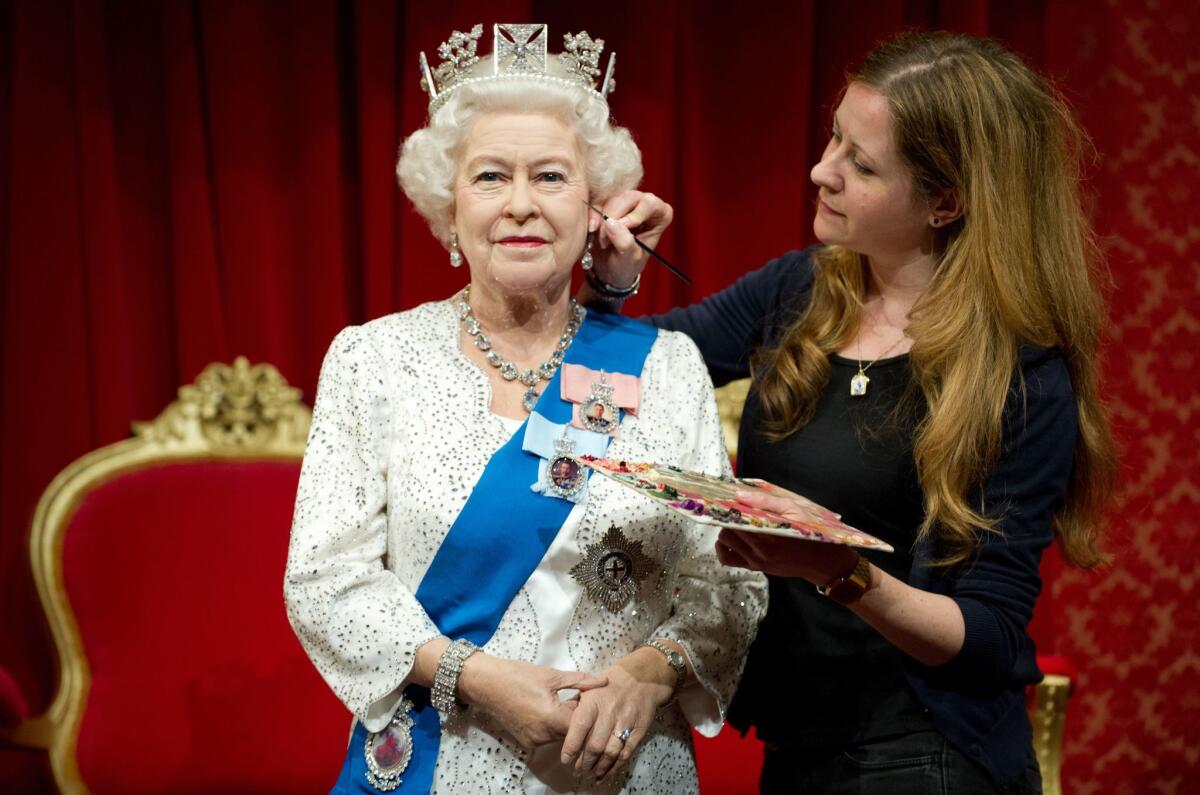The slightly twisted vision of Edward Carey and his imagined Madame Tussaud
- Share via
Is it possible to write a fantasy novel that has no elements of fantasy? Or a graphic novel that has only occasional graphics?
Author Edward Carey, an Englishman who lives in Austin, Texas, certainly thinks so. His new novel, “Little,” (out now from Riverhead) makes up a strange hybrid of things that don’t normally go together but feel perfectly comfortable when he sets them alongside one another.
The novel — based on the story of Madame Tussaud, the wax sculptor and founder of the famed London museum — could have been rendered in a literal or thudding, conventional style. But to what’s already a lively tale, overlapping in both ordinary and macabre ways with the French Revolution that broke out when she was in her 20s, Carey brought a twisted point of view somewhere between Lemony Snicket and Tim Burton and — in the drawings that pepper the novel’s pages — something between Marjane Satrapi and Edward Gorey.
“She’s like a folklore character,” Carey, 48, says of Tussaud, the diminutive woman born Anna Maria Grosholtz in Alsace and who soon became an orphan and an accidental world traveler. “Like your Johnny Appleseed. How could she have really existed?”

Over the years, Marie, as she was known, would apprentice to an eccentric Swiss doctor, live in borderline poverty as a Parisian servant, move into the palace of Versailles while working for King Louis XVI’s sister Élisabeth, develop great skill at sculpting heads out of wax and watch her creations become totems in the revolution’s unrest. “She’s the tiny girl you’d go to,” Carey says by phone from Austin, “if you needed a severed head on a pike.”
Marie went on to be imprisoned during the Reign of Terror, cast Robespierre’s guillotined head, sculpt the figure of Napoleon and flee to Britain, where she traveled for years with her collection of heads and torsos.
But to enjoy the novel, a reader does not need an existing investment in Tussaud or waxworks, any more than responding to Hilary Mantel’s “Wolf Hall” relies on a burning interest in Thomas Cromwell.
Carey enjoys the contrast between this small, unassuming narrator and the huge, violent, planet-transforming sweep of the world around her. “After the rubble, she crawls out of it,” Carey says. “She basically crated up the French Revolution, brought it across the Channel, unpacked it and said, ‘Here it is.’”
The genesis of Carey’s novel occurred, effectively, two full decades ago. When the author was in his 20s, he worked at the flagship London location of Madame Tussauds on Marleybone Road. He went partly because he’d been unsettled by the place as a child, partly because he could not find more suitable work.
“It seemed then, and it seems now, like one of the most bizarre forms of entertainment,” he says. “Why would you do that? I was fascinated with the waxworks, and with the obsession of some people; there are still enormous queues.” Although his job was mainly trying to keep people from touching the figures, an IRA bombing that took place one night made it feel that the revolutionary violence of Tussaud’s life had come back to the place.
It was only in the years after he worked there that his fascination with Tussaud herself hit full pitch. “There’s something mythical about her, as if she were a character from folklore or fairytale,” he wrote recently in the Guardian. Over time, he realized, “She feels made up, she seems like a story.”
She’s the tiny girl you’d go to if you needed a severed head on a pike. - Edward Carey
In the ensuing years, Carey worked as a playwright, moved to Romania and other parts of Europe, and then, while dwelling in the French countryside, “living off little more than cigarettes,” decided he had to tell Marie’s tale. But after reading her memoir, and spending months of research at the British Library and in Paris archives, he realized he wasn’t ready for it. He grew so frustrated trying to get Marie’s voice right that after a few years, he abandoned the project.

A handful of things brought Carey back to Marie’s story and allowed him to tell it. One of them was being in Austin, where he teaches at the University of Texas, is married to author Elizabeth McCracken and has two children. The thousands of miles of distance from the events of Europe, he says, freed him.
But the other has to do with something that happened along the way, and helped set the uncanny tone of the novel: He had become a YA writer and cultivated an interest in fantasy. His Iremonger trilogy — the first of which, “Heap House,” came out in 2014 — begins in a bizarre mansion built over an enormous rubbish heap made of cast-off items from across London. “Writing the kids books,” he says, “was a massive liberation.”
Carey, who moved to the U.S. for real in 2006 and taught a bit before and after at the University of Iowa, offers a class at UT on fairy tales. Concentrating on the tales of the Grimms, Charles Perrault, Angela Carter, “One Thousand and One Nights” and others reinforced his sensibility. He was struck as well by how much darker these tend to be than we think; though Hans Christian Andersen may be best known these days for “The Little Mermaid,” Carey sees him as remarkably close to Kafka.
“We still discover so much more from them; they’re endlessly open to interpretation,” he says. “It’s almost like taking the head off a human being and looking at what’s inside. They come up with fantastic images — like Rapunzel, you can only get up and down the tower with her long hair. One of the things fairy tales talk about again and again is the breakdown of class — people can escape poverty, become queens.”
Few events in the history of the world concern the overturning of class like the French Revolution. Coming back to the story of Marie about two years ago, he found that the tale was remarkably easy and brisk to write.
The ensuing novel reads, curiously, fairly close to the Iremonger books, though it’s aimed at grownups: Its style is antique, almost mannered, with plenty of grotesques, caricatures and surreal touches. “It took me until the end of the book,” wrote NPR’s reviewer, Amal El-Mohtar, “to realize this wasn’t a fantasy novel, but a work of historical fiction telling the origin story of Madame Tussaud.”
Carey sees the genres as being potentially close. “I feel like there are so many ways of writing historical fiction: You can do like Hilary Mantel, very detailed, or like Jeanette Winterson in ‘The Passion,’ with webbed feet and a lot of fantasy. I’m not very good at anything realistic.”
Speaking to Carey, and reading his books, with their strangely shaped people, weird drawings, objects that resemble human beings and obsession with miniatures, you get a sense that his mind works differently than most of ours. He feels an affinity with writers like Kelly Link, Karen Russell and Helen Oyeyemi, authors in their 30s and 40s “who have this excitement with the imagination, which can just burst out. I never set out to be part of any guild. But this is the only way I can work — through exaggeration.”
Timberg is a writer and editor who lives in Los Angeles and is the author of “Culture Crash: The Killing of the Creative Class.”
More to Read
Sign up for our Book Club newsletter
Get the latest news, events and more from the Los Angeles Times Book Club, and help us get L.A. reading and talking.
You may occasionally receive promotional content from the Los Angeles Times.










